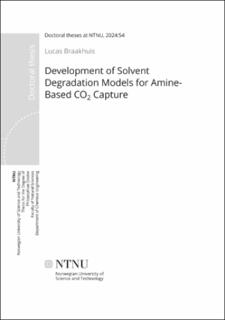| dc.description.abstract | Carbon capture and storage can be essential for achieving short-term emission reductions to reach climate goals and realizing the decarbonization of hard-to-abate sectors in the future. Aside from logistical and political hurdles to get the CO2 from separation to sequestration, continuous improvement of the capture technology is required to make capture processes more efficient and reliable and prevent operational and economic challenges. A good understanding of solvent degradation mechanisms and the effectiveness of solvent management strategies is essential to achieve these goals. Therefore, this thesis focuses on developing solvent degradation models for amine-based CO2 capture and their application to predict degradation behavior in capture plants.
Lab-scale experimental data on solvent degradation is used to develop degradation models for thermal and oxidative degradation of monoethanolamine (MEA), the most well-studied and characterized solvent for amine-based carbon capture. Both models accurately reflect degradation rates, thermal degradation product formation rates, and observed trends in the experiments as a function of experimental conditions. However, the models are characterized by relatively high deviations caused primarily by high experimental uncertainty.
More detailed reporting of experimental conditions, measured or expected uncertainties, and solvent composition during the experiments is required to improve the accuracy of the models. Furthermore, typical degradation reactors are unable to accurately replicate exposure conditions in the capture process, such as high O2 mass transfer rates and temperature swings. Therefore, a new degradation reactor, which aims to overcome these challenges, is designed, constructed, and tested. The first results of degradation experiments in this setup are promising, showing a good control of experimental conditions, and indicating increased oxidation rates.
The developed degradation models are used to make predictions of degradation rates throughout the process, which agree with observations in smaller cyclic systems and pilot plants. Oxidative degradation is the most prominent mechanism and occurs primarily in the absorber packing. Therefore, absorber intercooling, which reduces the temperature in the absorber, significantly reduces overall degradation rates. The effectiveness of other degradation-reducing process modifications, such as dissolved O2 removal or a reduction of residence times, depends on the flue gas composition and process-specific distribution of degradation throughout the plant.
The effect of dissolved metals on oxidative degradation rates of MEA is significant but the role of these metals is unclear. Modeling studies in this work show that quantification of the catalytic effect of metals and the impact of degradation product concentration on corrosion rates and metal solubility are likely to play a significant role. Therefore, additional experimental work is required to fill these knowledge gaps.
Although this work provides new, relevant insights into solvent degradation in CO2 capture plants, it has proven challenging to develop a framework that can accurately represent the many complexities of solvent degradation, even for a well-characterized solvent. | en_US |
